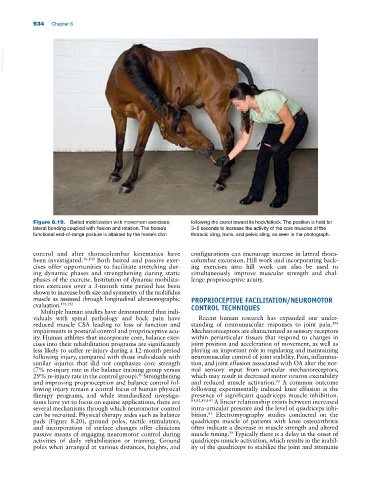Page 968 - Adams and Stashak's Lameness in Horses, 7th Edition
P. 968
934 Chapter 8
VetBooks.ir
Figure 8.19. Baited mobilization with movement exercises; following the carrot toward its hock/fetlock. The position is held for
lateral bending coupled with flexion and rotation. The horse’s 3–5 seconds to increase the activity of the core muscles of the
functional end‐of‐range posture is attained by the horse’s chin thoracic sling, trunk, and pelvic sling, as seen in the photograph.
control and alter thoracolumbar kinematics have configurations can encourage increase in lateral thora-
been investigated. 30,100 Both baited and passive exer- columbar excursion. Hill work and incorporating back-
cises offer opportunities to facilitate stretching dur- ing exercises into hill work can also be used to
ing dynamic phases and strengthening during static simultaneously improve muscular strength and chal-
phases of the exercise. Institution of dynamic mobiliza- lenge proprioceptive acuity.
tion exercises over a 3‐month time period has been
shown to increase both size and symmetry of the multifidus
muscle as assessed through longitudinal ultrasonographic PROPRIOCEPTIVE FACILITATION/NEUROMOTOR
evaluation. 191,192 CONTROL TECHNIQUES
Multiple human studies have demonstrated that indi-
viduals with spinal pathology and back pain have Recent human research has expanded our under-
194
reduced muscle CSA leading to loss of function and standing of neuromuscular responses to joint pain.
impairments in postural control and proprioceptive acu- Mechanoreceptors are characterized as sensory receptors
ity. Human athletes that incorporate core, balance exer- within periarticular tissues that respond to changes in
cises into their rehabilitation programs are significantly joint position and acceleration of movement, as well as
less likely to suffer re‐injury during a 12‐month period playing an important role in regulating and maintaining
following injury, compared with those individuals with neuromuscular control of joint stability. Pain, inflamma-
similar injuries that did not emphasize core strength tion, and joint effusion associated with OA alter the nor-
(7% re‐injury rate in the balance training group versus mal sensory input from articular mechanoreceptors,
80
29% re‐injury rate in the control group). Strengthening which may result in decreased motor neuron excitability
and improving proprioception and balance control fol- and reduced muscle activation. A common outcome
93
lowing injury remain a central focus of human physical following experimentally induced knee effusion is the
therapy programs, and while standardized investiga- presence of significant quadriceps muscle inhibition.
tions have yet to focus on equine applications, there are 81,82,89,143 A linear relationship exists between increased
several mechanisms through which neuromotor control intra‐articular pressure and the level of quadriceps inhi-
can be recruited. Physical therapy aides such as balance bition. Electromyography studies conducted on the
81
pads (Figure 8.20), ground poles, tactile stimulators, quadriceps muscle of patients with knee osteoarthritis
and incorporation of surface changes offer clinicians often indicate a decrease in muscle strength and altered
passive means of engaging neuromotor control during muscle timing. Typically there is a delay in the onset of
39
activities of daily rehabilitation or training. Ground quadriceps muscle activation, which results in the inabil-
poles when arranged at various distances, heights, and ity of the quadriceps to stabilize the joint and attenuate

